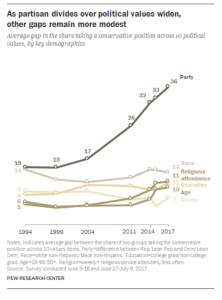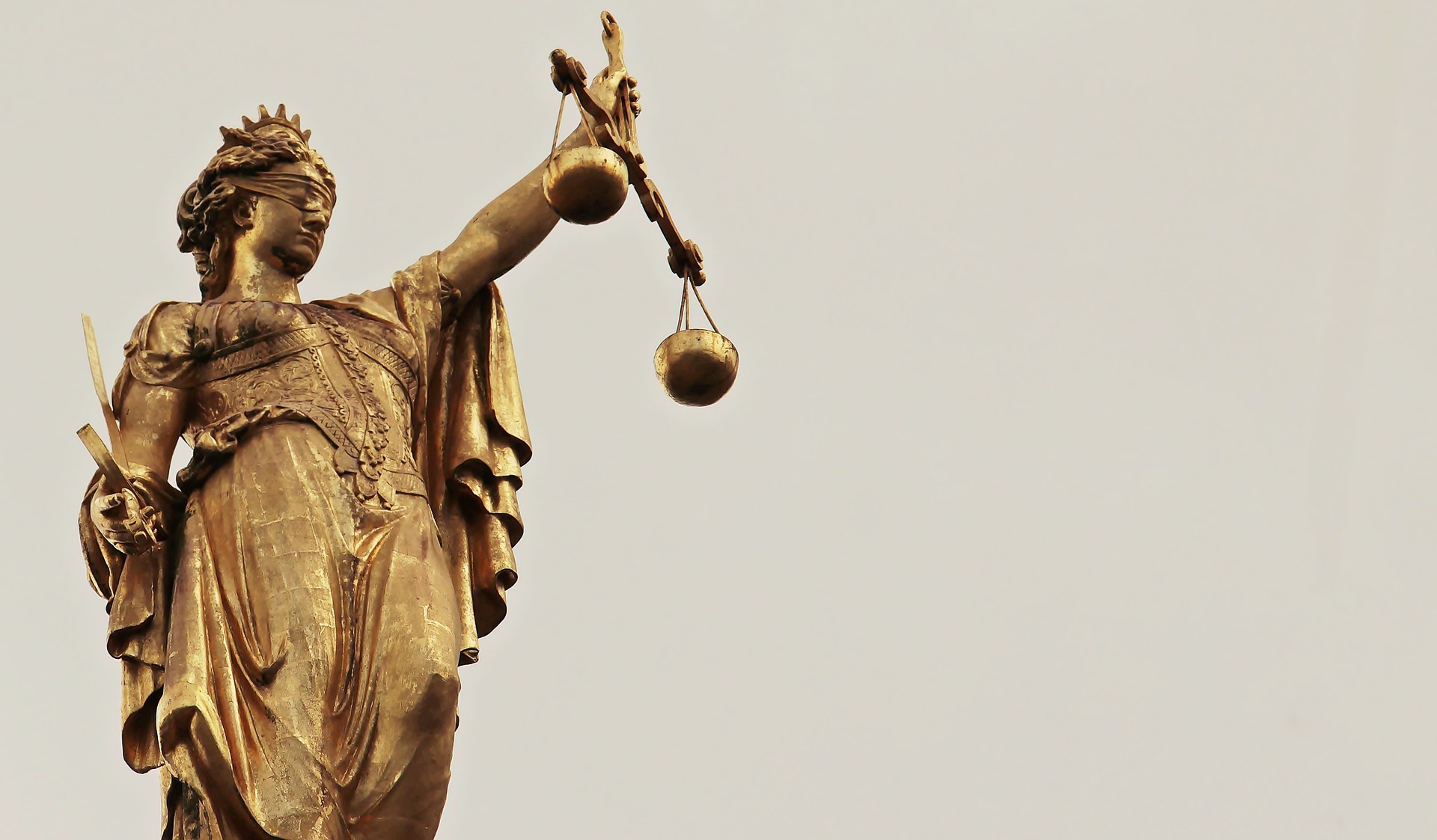There is no middle; there is no moderation. There is only endless argument between Republicans and Democrats who have fundamental issues with their opposition. Compromise in today’s politics is seldom reached, and too often each side is so embroiled with their hatred of their opponents that they fail to bring about any real change. For example, at the time of writing, the longest government shutdown in history continues.[1] The two major factions argue constantly over everything from the monumental to the minutiae in the Senate and House. The ruling parties in America and their domination of our political system have inspired factions of our citizenry to turn into proselytizing zealots, bent on crushing the other side to assert their respective agendas. This ideological warfare—the accusations of socialism and cries of “SJW!” by the right and accusations of racism, homophobia, and fascism by the left—has become pervasive in our political discourse, and it is tearing our country apart (see: Pew Research graph below). We, as a society, must improve our ability to have conversations about serious issues without the influence of extremism muddying the waters. We must modernize the structure of our government and electoral process into one that is less inherently polarizing. Without these changes, the political extremism that impedes change will continue to persist in American political life.
http://www.people-press.org/2017/10/05/the-partisan-divide-on-political-values-grows-even-wider/
Political extremism has risen dramatically over the course of the last decade. According to a Pew Research Study, partisanship over political values has grown rapidly since the turn of the millenium, whereas partisanship over values such as religion and race has remained relatively constant.[2] During George W. Bush’s presidency, Republicans were pulled toward the center, while Democrats were pushed further left. In 2011, during President Obama’s first term, Republicans shifted back towards the right. This shift is likely connected to the Tea Party movement, which grew as a reactionary opposition to President Obama’s new political projects. However, a larger shift in partisanship was observed between 2011 and 2014, when measures of partisanship among both Republicans and Democrats were pushed towards their relative extrema. There is speculation that this shift may have occurred in response to the Republican establishment blocking Democratic legislation after the 2010 congressional reshuffling.[3] Between 2010 and 2016, Republican obstruction prevented Democrats from having practically any chance to enact proposed policy.[4] When the anti-establishment President Trump was elected and Congress was fully Republican-controlled, Democrats knew their goals were even more unlikely to come to fruition, leading Democrats to become more fervorous in their defense of their established ideology.
In a span of less than two decades, partisanship based on party has more than doubled.[5] This partisanship has taken a toll on our political psyche, both on the left and right, and everywhere in-between. From the far-right, insults were hurled at Senator McCain, a once revered member of the Republican Party, for questioning and often opposing their leader, President Trump.[6] From the left, we saw fury directed at conservative Democrat Joe Manchin for his vote confirming Trump-nominated Justice Brett Kavanaugh.[7] This outrage wouldn’t be as much of a problem if the far-left and the far-right were represented by their own parties, separate from the dominant two, Democrats and Republicans. However, because extremists and moderates on either side are grouped into the same party, voices of moderates are often overshadowed by the more outspoken, radical members of each party. This quelling of moderate voices is exacerbated by the design of the American political system.
How is it possible that such impeding political stratification could occur within a country that is seen as a symbol of modern democracy? The answer lies in part within America’s primary election system. This process facilitates the polarization of our elected officials by encouraging candidates to adopt positions that are not necessarily conducive to winning over the general electorate. Instead, they align with the beliefs of their respective primary electorate in order to give them the best chance to make it to the general election. This is largely due to the unfortunate fact that fewer people vote in the primaries than in the general election.
In the 2016 presidential election cycle, primary turnout hovered around 30% for the vast majority of states, with only one state (New Hampshire) surpassing 50%.[8] This is much lower than the 60.1% of eligible voters who voted in the general election. As University of Illinois economist Mattias Polborn succinctly stated: “the fundamental problem is that Democratic and Republican primary voters are quite extreme.”[9] This forces candidates who are vying for a chance to make it to the general election to appease their base of primary voters first, placing them at odds with independent and moderate voters from the other party.
In closed primaries, only voters registered with a party can vote in that party’s primary, limiting the voice of moderates who do not always vote within their registered party, and independents, who are barred from voting altogether.[10] If open primaries were the norm across the United States, voters would be able to vote in either party’s primary, allowing for any individual to vote for the candidate with whom they most closely align. This would hopefully encourage voters to turn out for the primaries in numbers more similar to those of the general election.
An interesting mathematical device has been developed to determine the ‘best’ candidate in an election: the Condorcet Method.[11] This method is analogous to a classic tournament structure in which each candidate faces off in a head-to-head battle against every other candidate. According to the laws of logic, there will always be an undefeated candidate by this method (the strong Condorcet Winner) who would hypothetically satisfy the largest amount of the electorate. Unfortunately, this candidate rarely actually wins the general election. Candidates who satisfy the majority of the general electorate by gaining many of the independent and moderate votes from each side routinely lose in primaries because they are not partisan enough to win over polarized primary voters.
One solution to the problem induced by primaries would be to adopt a more open voting system with preferential voting, two-stage voting, or a party-proportional voting system. America may have been the first modern democracy, but that does not mean that our system is flawless. Many nations (e.g. the United Kingdom, France, Germany, Norway, India) have adopted parts of our political structure—most notably, the separation of powers into three branches—while effectively altering other aspects of the election system.[12]
With a voting process like preferential voting, which is already widely used in comparable nations to the United States, such as Australia, citizens are able to choose their top three candidates, each weighed accordingly.[13] This allows people to vote for candidates from smaller parties free from the idea that “a vote for X is a vote wasted.” Currently, people often vote for the party or candidate that is the “lesser of two evils” rather than a candidate with whom they truly align. With a system of preferential voting, it is much more likely that a party will represent values closer to those of voters and that there will not be a true majority, but rather a plurality in Congress. One would think that this would only increase the gridlock that already exists; however, some gridlock may not be such a terrible thing. If every law flew by Congress, the potential for the passage of harmful legislation would increase drastically. The notion that it is very difficult for proposed congressional legislation to become law is an underappreciated beauty of the American political system. A greater number of parties in the federal government encourages parties to form coalitions and to make concessions with other parties in order to get laws passed, thereby making the laws that are ultimately passed truer representations of what the average voter wants.
The process to elect the President of France also lends itself to less political partisanship: the “Two-round System,” in which the election is split into two distinct rounds. In the first round, voters choose from a large selection of candidates, from any number of political parties. If no candidate receives an undisputed majority (more than 50% of all votes cast), then the election proceeds to round two. In round two, the two candidates who received the most votes in round one enter a runoff. Whoever receives the most votes in the runoff is declared the winner.[14] This system has benefited France by giving more leverage to individual ideologies, allowing for niche groups to take the center stage. The National Front, the primary far-right party in France and the party of runner-up Marie Le Pen, holds only eight seats out of the 577 seats in the French National Assembly. As demonstrated by the defeat of Marie Le Pen by a 33 point margin in the 2017 French Election, extremist ideas are difficult to carry against a more rational ideology that has widespread appeal. The two-round system also provides a buffer against the effects of voter apathy. In the 2002 French Election, voter turnout dropped by a significant margin, allowing for the more extremist National Front voters to get the anti-semitic, nationalist Jean-Marie Le Pen (Marie Le Pen’s Father) into the second round.[15] However, with the public realizing the threat of possibly electing such a person to represent France, they had a chance to stop the far-right movement. In the second round, voter turnout rebounded back to normal, and Jean-Marie Le Pen was defeated by 20 million votes.[16] A two-round system can inspire voters to fight the rising tides of extremism and encourage the electorate to question and critically consider the direction in which their country is heading.
A third election system exists in Sweden’s Riksdag (National Legislature) and Japan’s House of Representatives, where members are selected by a system called Party-List Proportional Representation.[17] In this system, members are placed into their legislature based on the proportion of the votes their party received. For example, if a party receives 20% of the vote, then 20% of the legislature will be populated with legislators of that party. These legislators are usually on an electoral list: a full list compiling all candidates eligible to be elected through the proportional system.[18] This list can either be open, with the electorate having sway over who has priority over other candidates, or it can be closed, with the priority of candidates being predetermined by the party. Sweden uses an open electoral list, while Japan uses a more closed list by which parties elect their top candidates within the party for 40% of the available seats and the remainder are elected outright.[19] This system allows for both moderate and extreme politicians to exist in the same legislature without fear that the will of the extremists will bring the left or right further to the edges of the spectrum.
Political extremism is a global problem. In order to remedy the extreme partisanship in the United States, our political system needs to be modernized. A growing portion of voters are tired of the “status quo” and want a radical shift in their country’s ideology. More often than not, countries have systems in place in which parties are encouraged (by the government) to focus on the majority of voters. In the United States, however, the alt-right and moderate Republicans are represented by the same individuals, whose views do not wholly align with the beliefs of either group. The Democratic party is constantly fracturing due to differing ideologies between the far-left and the moderate-left.[20] The current system is inefficient, and certain popular views are ignored due to extremists asserting their agenda on the leadership of major political parties. Our current political system encourages constant feuding between two parties, rather than advancing political discourse. The only way we can begin to give a voice to all Americans is to modernize the American voting and legislative systems up to standards set by other parts of the modern world.
[1] “Government Shutdown 2019.” Politico. Last updated January 24, 2018. https://www.politico.com/latest-news-updates/government-shutdown-2018.
[2] “The Partisan Divide on Political Values Grows Even Wider.” Pew Research Center. October 05, 2017. http://www.people-press.org/2017/10/05/the-partisan-divide-on-political-values-grows-even-wider/.
[3] “2010 Election House Map.” The New York Times. Accessed November 08, 2018. https://www.nytimes.com/elections/2010/results/house.html.
[4] Grunwald, Michael. “The Part of No: New Detail on the GOP Plot to Obstruct Obama.” Time. August 23, 2012. http://swampland.time.com/2012/08/23/the-party-of-no-new-details-on-the-gop-plot-to-obstruct-obama/.
[5] “The Partisan Divide on Political Values Grows Even Wider.” Pew Research Center.
[6] Rhodan, Maya. “A Brief History of Donald Trump’s Feud with John McCain.” Time. August 27, 2017. http://time.com/4993304/john-mccain-donald-trump-feud-remarks/.
[7] Everett, Burgess. “Manchin goes full MAGA.” Politico. June 06, 2017. https://www.politico.com/story/2018/06/06/manchin-trump-west-virginia-midterms-626437.
[8] McDonald, Michael. “2016 Presidential Nomination Contest Turnout Rates.” United States Election Project. http://www.electproject.org/2016P.
[9] Ciciora, Phil. “Why Not Have One National Primary Election For Presidential Nominees?” Illinois News Bureau. February 16, 2016. https://news.illinois.edu/view/6367/327882.
[10] “Open and Closed Primaries.” Fairvote. https://www.fairvote.org/open_and_closed_primaries.
[11] Goldberg, Timothy. “Condorcet’s Method and Condorcet Winners.” Cornell Mathematics 1340: Math and Politics. Summer 2010. http://pi.math.cornell.edu/~goldberg/Math1340/CondorcetCleanup.pdf.
[12] Louis-Jacques, Lyonette. “Influence of the U.S. Constitution Abroad,” University of Chicago Library News. September 17, 2011. http://news.lib.uchicago.edu/blog/2011/09/17/influence-of-the-u-s-constitution-abroad/.
[13] Green, Antony. “Antony Green’s Election Guide: How Preferences Work.” ABC News. Accessed November 08, 2018. http://www.abc.net.au/elections/federal/2004/guide/howpreferenceswork.htm.
[14] Sindreu, Jon. “France’s Two-Round Electoral System Spells Period of Volatility for Markets.” Wall Street Journal. April 27, 2017. https://www.wsj.com/articles/frances-two-round-electoral-system-spells-volatility-for-markets-1492776238.
[15] Henley, Jon. “Le Pen Vote Shocks France.” The Guardian. April 22, 2002. https://www.theguardian.com/world/2002/apr/22/thefarright.france.
[16] “Chirac Landslide against Le Pen.” CNN. May 6, 2002. http://edition.cnn.com/2002/WORLD/europe/05/05/france.win/.
[17] Savage, James. “How Sweden’s Election Works. ” The Local. September 15, 2006. https://www.thelocal.se/20060915/4899.
[18] “Proportional Representation.” Encyclopædia Britannica. December 06, 2017. https://www.britannica.com/topic/proportional-representation.
[19] “The Government of Modern Japan: Elections.” Asia for Educators, Columbia University. 2009. http://afe.easia.columbia.edu/special/japan_1900_elections.htm.
[20] Sarlin, Benjy. “In New Video, Ocasio-Cortez Joins Progressive Effort to Oust More Incumbent Democrats.” NBC News. January 16, 2019. https://www.nbcnews.com/politics/2020-election/new-video-ocasio-cortez-joins-progressive-effort-oust-more-incumbent-n959121.




